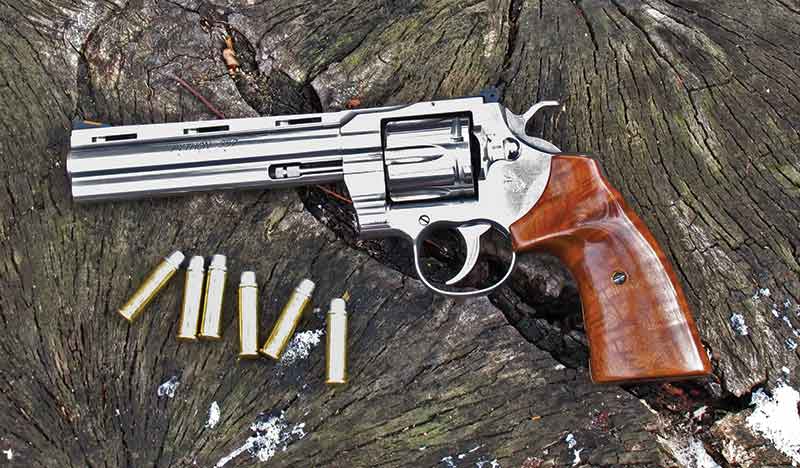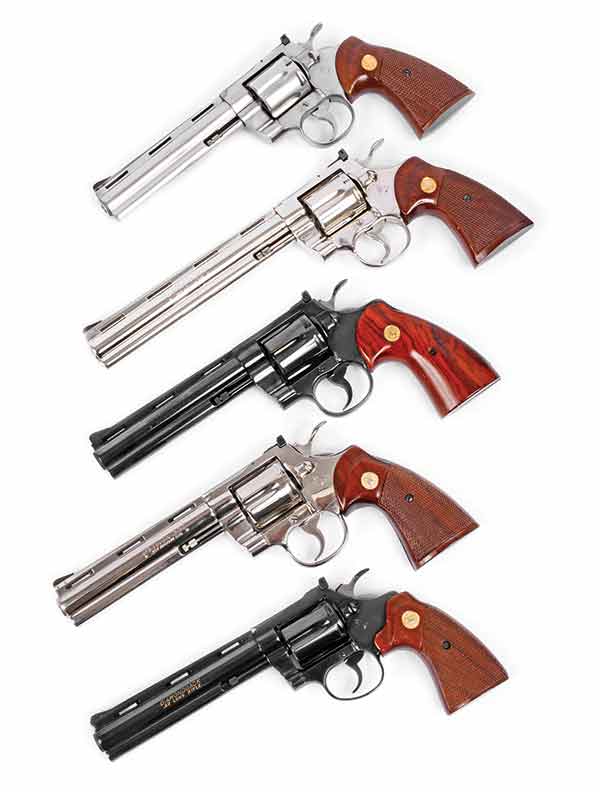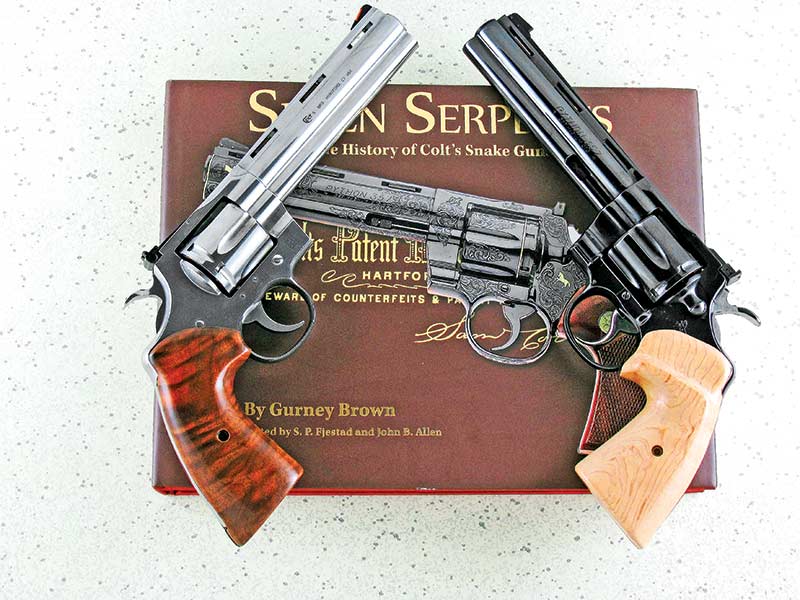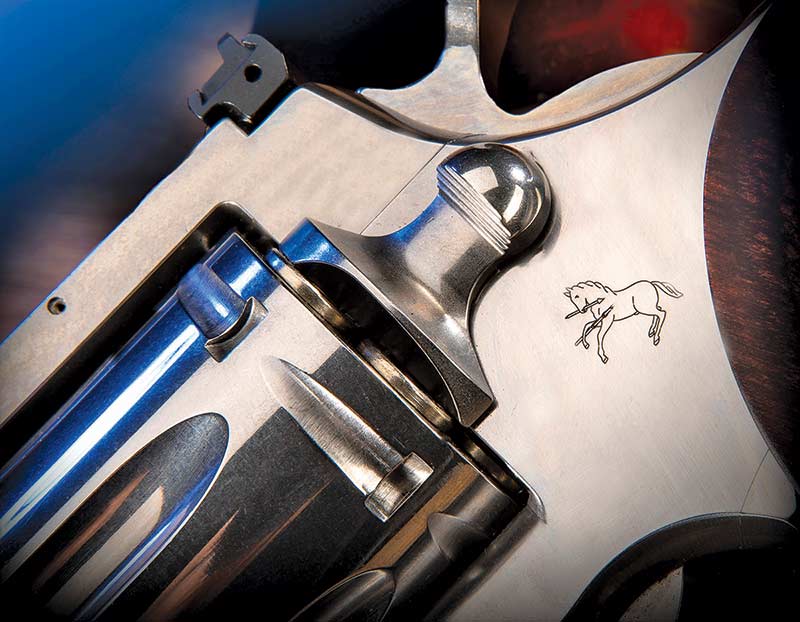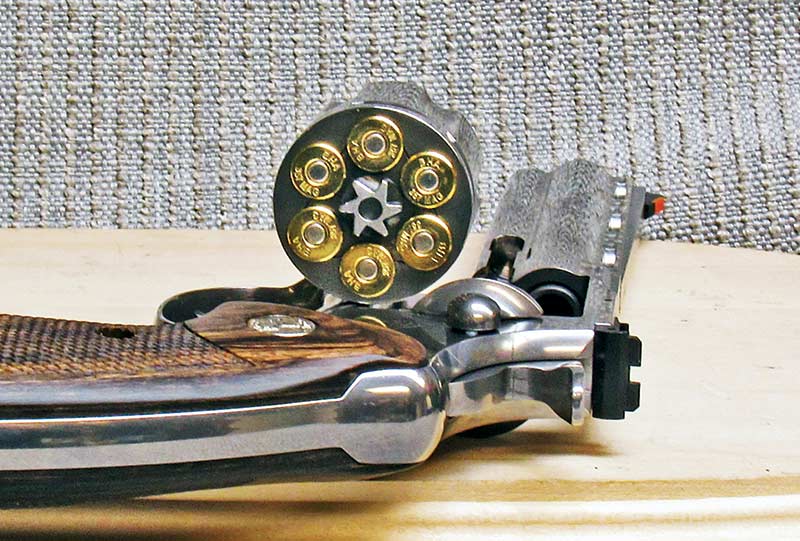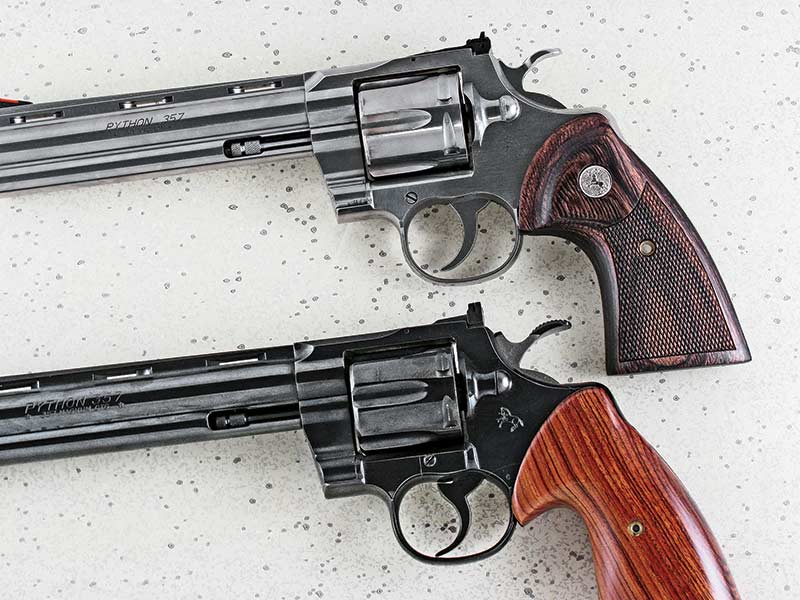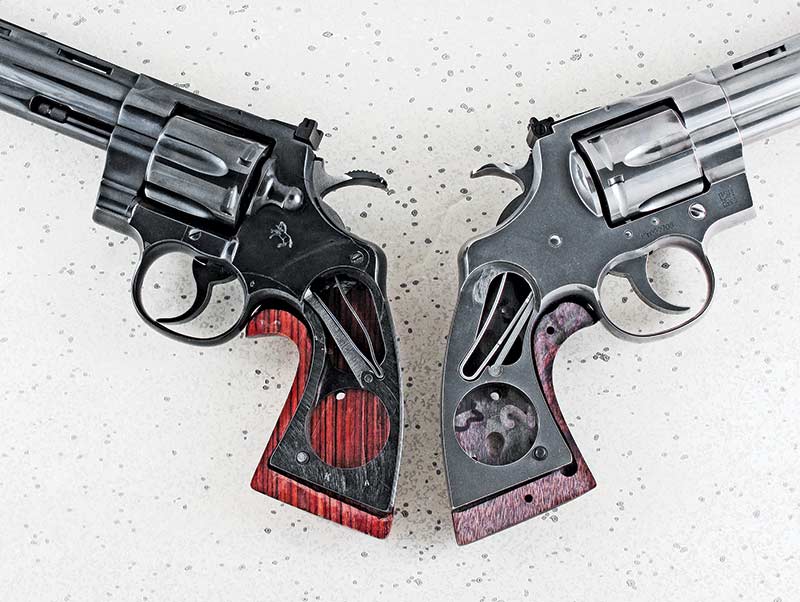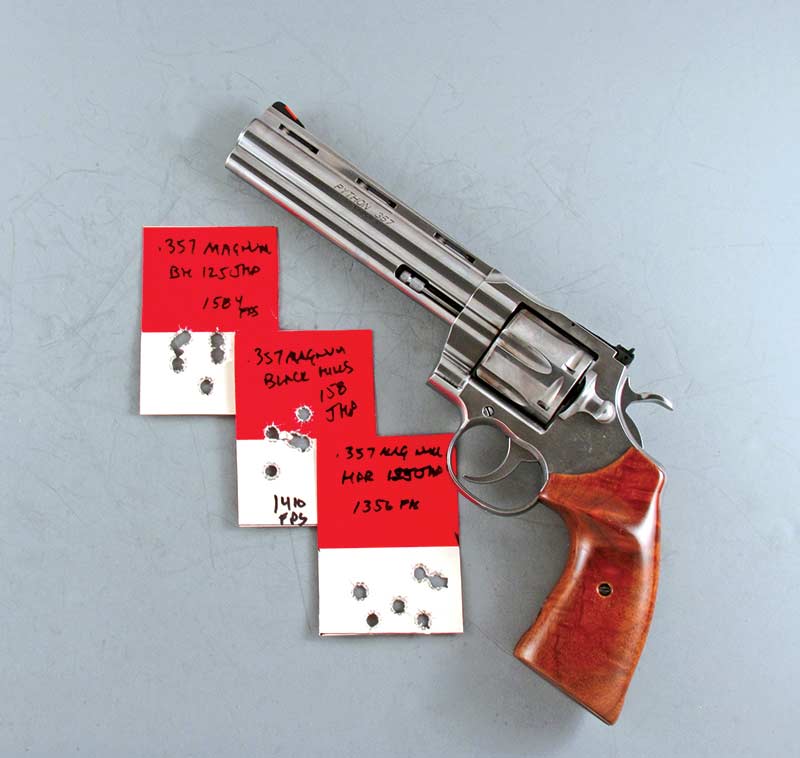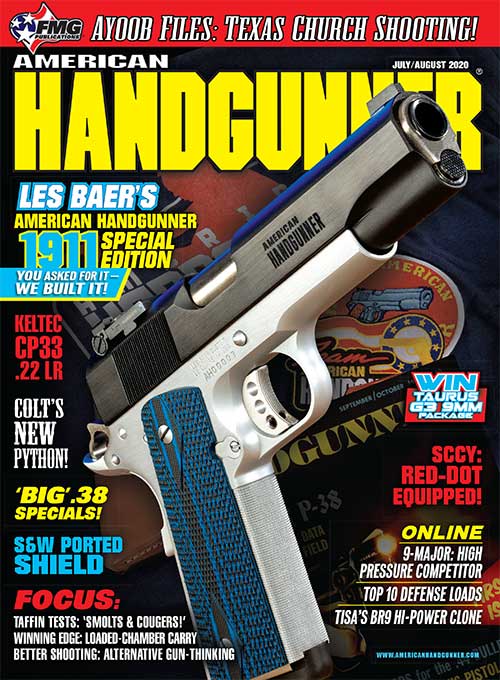The Colt Python
A Delightful Retro-Surprise
It was circa-1955. Bullseye shooting, where you stood on your hind legs and shot one-handed is king. Cops’ holsters are filled with either a Colt or S&W DA revolver, with more of the former than the latter. Both companies are about to make major changes in their sixguns — one negative, one positive. The target shooters of the day gravitated more to the Colt while those masters of double action shooting preferred the S&W. The number one Colt target revolver was the .38 Special Officers Model Match, while the fixed-sighted version, the Official Police, was favored by law enforcement. S&W’s target revolver was the K-38.
According to one of the experts of the day, Bob Nichols, author of The Secrets of Double Action Shooting (1950) had this to say of the old “long action” S&W sixguns:
“The standard-action Smith & Wesson double-action revolver in the .38 Special Military & Police Model is the best gun …. If you cannot learn double-action hitting within a month, then abandon pistol shooting and concentrate on learning to throw rocks through a barn door. Pistol shooting may not be for you.”
Then S&W changed the action from the old long action to the new short action to accommodate target shooters. You can almost see the tear stains on the pages of Nichols’ book as he says:
“Don’t waste time trying to learn double-action shooting with the new short action Smith & Wesson revolver, however, this gun is built strictly for the single-cocking bullseye pistol man.”
Colt Takes Advantage
S&W destroyed the finest double-action shooting sixgun ever to accommodate target shooters. Meanwhile Colt was seeking to make their Officers Model Match .38 Special an even better target pistol. The action was specially tuned and polished and a new heavy barrel was designed. Up to this time all Colt DA revolvers had an ejector rod sticking out in front of the frame, noticeably unprotected from damage. This new Target .38 featured a ribbed heavy barrel with a full length under lug, enclosing the ejector rod.
The whole idea resulted in a very heavy, too heavy at 31/2 lbs., for target shooting — beautiful revolver. Colt changed directions and instead of a .38 Special for target shooters, reduced some of the weight by ventilating the rib and milling out the slot for the jector rod even more, deciding this would make a great .357 Magnum.
The Python Was Born
Since this was the finest sixgun Colt ever produced, it was given a deluxe Royal Blue finish and hand-honed action. It’s one of the most accurate revolvers you’re ever likely to encounter, too. It balances superbly with the heavy barrel that was a trendsetter in 1955 and is now practically a standard feature on all DA revolvers.
While the Python cocks oh so smooooothly for single action shooting, the DA operation has never felt quite as smooth to me as a tuned Smith & Wesson. That’s one of the problems inherent in the Python. The second is the Python has always been expensive to produce, and the lock work goes all the way back to the 19th century, and frankly, is somewhat fragile.
Rebirth
Both of these problems have now been addressed as Colt has resurrected the Python for 2020.
The New Python is not a duplication of the original. It looks just like a Python, complete with the heavy under-lug, ventilated rib barrel, having always been a mark of the Python. The grip frame is also identical to the original. Four grips I pulled out of my parts box for the original Python/Officers Model Match/Official Police/.357 Magnum all fit the new Python.
There are two obvious differences on the outside, though. One is the fact the top strap has been increased in size by about 30 percent, and the screw above the trigger guard on the left side is now placed farther to the front, indicating a change in the inner mechanism.
The lock work has been changed not only to make it stronger and less susceptible to going out of time but also to make it easier to shoot double-action. Again quoting Bob Nichols:
“The Colt double action revolver is not capable of double action accuracy fire …. In its double-action function the Colt double action revolver has a poor trigger pull and a most unresponsive cylinder ‘roll’.” The latter refers to Smith & Wesson’s long action cylinder that seems to almost rotate itself as you fire. The original Python had a DA pull which “stacked” meaning you could pull the trigger back to a certain spot in DA mode and then almost fire as you would a single action. This worked for some people but not for most shooters. This has now been corrected and the new Python has one, straight pull DA without the two-stage operation of the original.
One major thing, thankfully, is the fact Colt did not change the barrel. It’s still one-piece complete with barrel, under lug and ventilated rib forged out of a single piece of steel. They did not follow what so many manufacturers have currently done, making two-piece barrels consisting of a barrel and a shroud.
The rear sight is fully adjustable and the front sight now features an interchangeable system with the sights held in place by an Allen screw. The Python comes with a front sight with a red insert, however other sights are available, including a fiber-optic version.
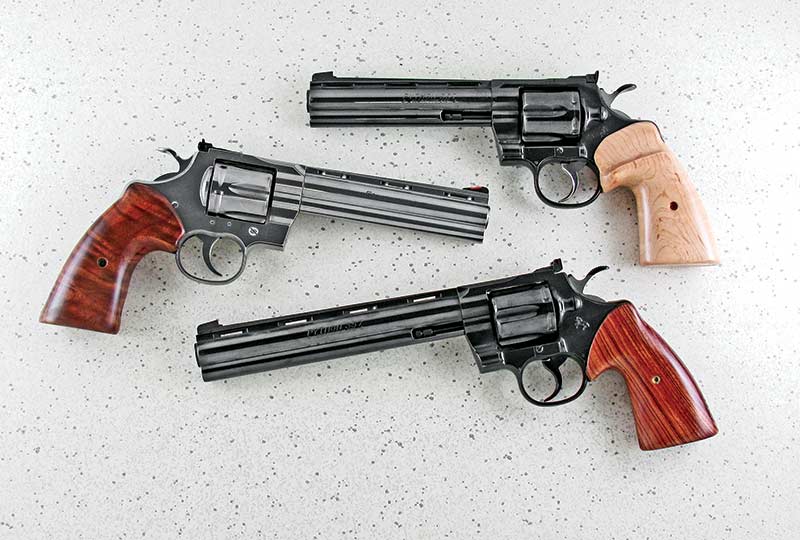
Bottom left: Factory .38 Special loads proved easy to shoot and just as accurate as the .357 loads.
The Python’s roots as a target revolver show. Custom Herrett stocks pictured. Bottom right: Targets
fired at 20 yards with .357 Magnum factory ammo showed the new Python continues the tradition
of gilt-edged accuracy.
Supernaturally Smooth
The Python is currently available only in stainless steel and I don’t expect that to change. Barrel lengths of 4.25″ and 6″ are listed, but I would like to see an 8″ version, if anyone is listening. With unloaded weights of 42 and 46 oz. respectively, the latter is three ounces more than the original Python, so steel has been added in critical places. The more critical specs are a 5-lb. single action trigger pull and 10-lb. DA. Both are smooth and creep-free, and the cylinder throats are all a uniform 0.35″.
I have two original Pythons from the 1960s to compare with the new Python. My original Python came about as a result of lust, I admit it. Sixgun lust. I managed to ignore the Python in the 1950s. The translation meaning I couldn’t afford one and also buy a Colt Single Action Army, both of which sold for $125 each. In 1956, at a time I was making 90 cents an hour, I purchased the first new .45 Colt 71/2″ to arrive in my area and managed to resist the Python.
Then in the 1960s Colt began to advertise the 4″ Python, using full-sized pictures. I wanted the gun so badly! At the time I was working the evening shift at General Tire while going to college during the day and supporting my family, which included three little babies. There was no money for a Python, no matter how badly I wanted one. However when I found one at the company store — I bought it on payroll deduction.
I never could make that Python shoot to my satisfaction until I replaced the 4″ barrel with an 8″ barrel, and had Bill Laughridge at Cylinder & Slide tune the action and smooth out the trigger pull. It became the proverbial tack driver.
The other Python is a 6″, tuned by Fred Sadowski and willed to me by my dear friend Jack Pender. It’s also an excellent shooting pistol and both of these are fitting examples to compare the New Python to. And it does compare favorably.
The new gun functions perfectly and shoots accurately. Cocking the hammer on the original Python is almost a supernatural experience. The new Python with its upgraded action does not feel quite the same way — but almost. I’m happy to trade the feeling to gain the much improved double-action. I did not get rid of the 4″ barrel but rather had it installed on a S&W .357 Combat Magnum by Milt Morrison of QPR. The advantage was gaining the smoother DA pull of the S&W. However, now it comes automatically with the new Python.
Accurate — Or Not?
The new Python was test fired with both .38 Special and .357 Magnum factory loads. I have a large supply of handloaded .357 Magnum rounds, both with cast and jacketed bullets. However, as I write this it’s late January and I’m definitely a fair weather shooter at this time of my life. These handloads will have to wait until the temperature is closer to the bullet weight than it is to the weight of the powder charge. Spring will come as it always does.
Meanwhile I have had excellent results with factory loads. With the .38 Special rounds the SIG SAUER 125-FMJ delivers 924 fps, and the Speer Gold Dot-HP 125 +P, 1,121 fps. Both put their shots right at 1″ shooting from 20 yards. I tried Black Hills .357 loads, their 125-JHP (1,584 fps) and their 158-JHP (1,410 fps) acquiring 1″ and 11/4″ groups respectively for five shots at 20 yards. Both the HPR 125-JHP (1,356 fps) and the SIG SAUER 125-JHP (1,350 fps), both .357 loads, put five rounds into 13/8″.
With both .38 Special and .357 Magnum loads shooting so well it tells me this gun will certainly perform. I had one exception, which again points out all loads should be checked out thoroughly before using them seriously. When I tried the Hornady .357 Magnum soft lead swaged 158-SWCHP load the Python threw the bullets about 4″ to the left, with key holes resulting. My guess is the softness of the lead alloy did not allow the rifling to properly grip the bullet. This is why I always use hard cast bullets for magnum loads — and especially in the .357 Magnum. It’s also rare I do not use .357 bullets with gas checks applied.
I had no malfunctions of any kind with this Python that were gun related and the only exception to great shooting loads was the above-mentioned soft lead bullet.
A Collectible?
It appears Colt has really done their homework for this resurrection of the Classic Python. It’s also different enough I don’t see it having any effect on the collector prices being received for Pythons from the last century. Those who purchase it will be buying a shooting sixgun — not an investment. With an MSRP of $1,499, at first glance it seems very expensive compared to the original price in 1955 of $125. However, when you compare minimum wage levels at the two time periods the new Python is actually less expensive. Ha! Suddenly it’s easier to justify buying one!
For more info:



